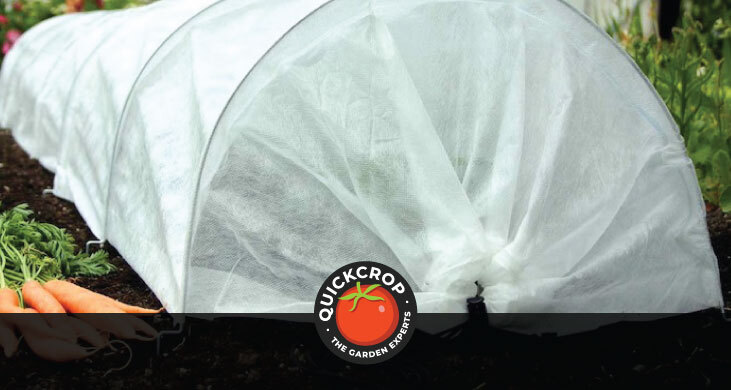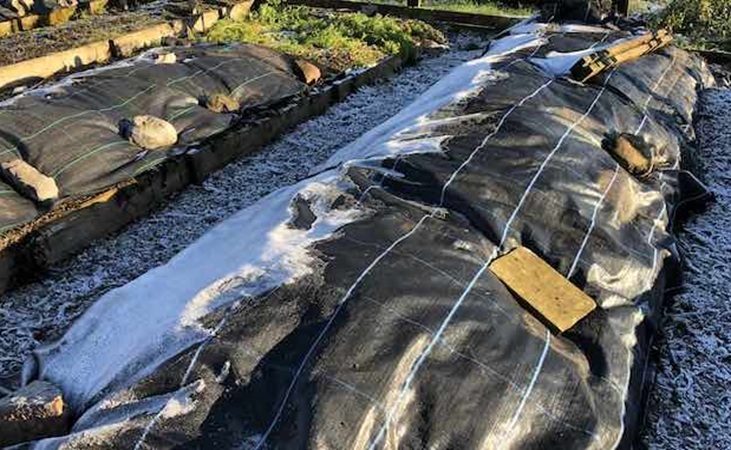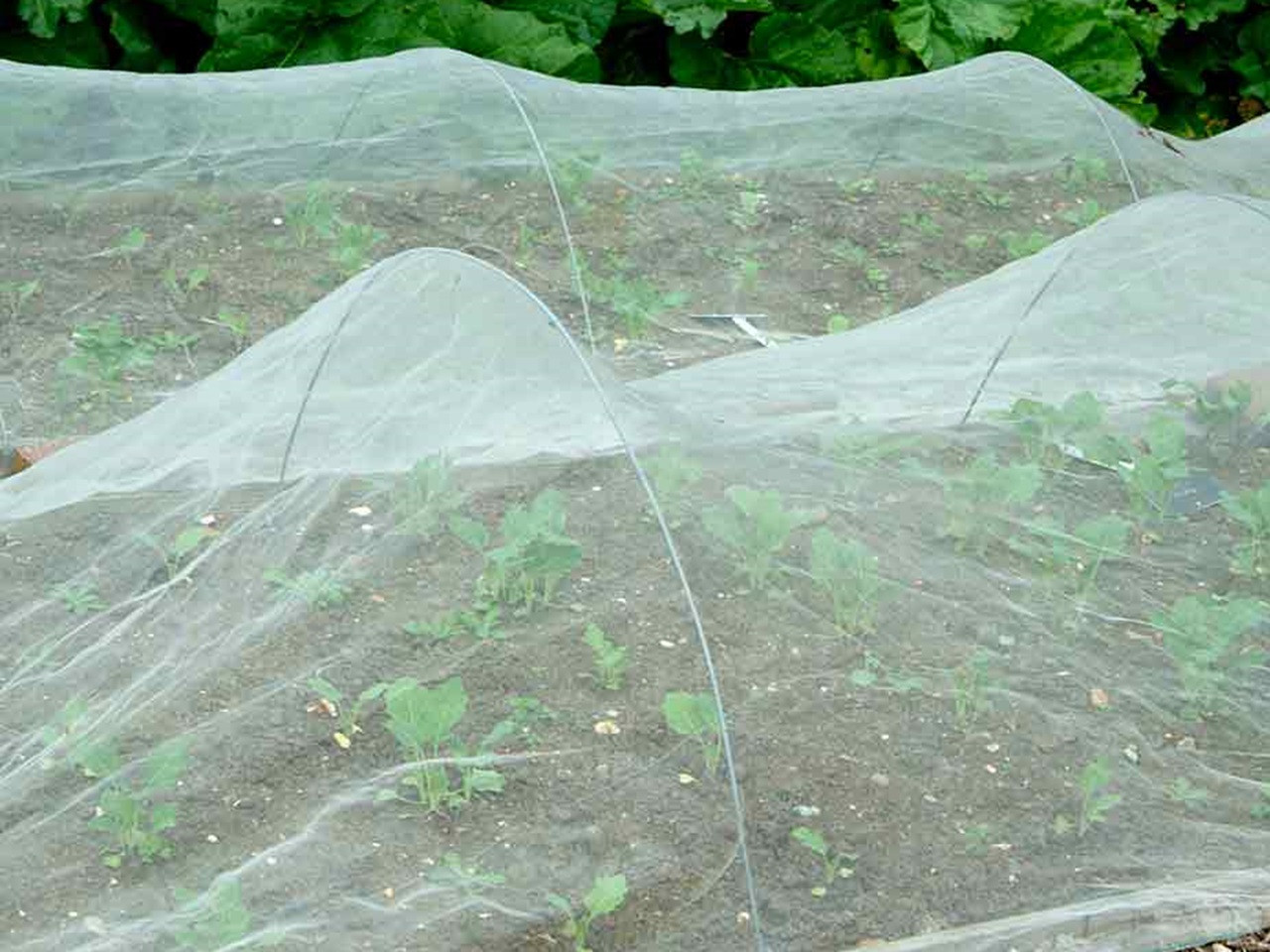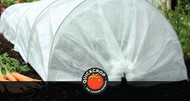A Grower's Guide to Crop Covers and Plant Protection

Plant protection is the practice of managing weeds, 'pests' and diseases that could otherwise damage or inhibit the growth of your crops, as well as mitigating the effect of weather extremes.
Strategic crop protection such as netting or mulching can be vital to success in the garden. It helps to create a more stable growing environment where plants are less troubled by weather extremes or common stresses.
The Benefits of Using Plant Protection Methods
1. Protect Crops from Insects etc
Critters like aphids, caterpillars, beetles, and slugs can cause significant damage to leaves, stems, roots, and fruits. Unchecked infestations can:
- Reduce crop yield and quality
- Stunt plant growth
- Kill young or vulnerable plants
2. Safeguarding against Disease
Fungal, bacterial, and viral diseases can be soil-borne, airborne, or transmitted by insects.
3. Reducing Weed Competition
Weeds compete with garden crops for water, nutrients, and light. They can also harbor pests and disease.
4. Protecting from Weather Extremes
Excessive rain, frost, hail, or strong winds can harm crops, especially young or tender plants.

5. Increasing Yield and Quality
Healthy plants that are free from stress are more productive, and will produce better-quality fruits and vegetables.
6. Reducing Chemical Use
Physical crop barriers and strategic plant protection methods can reduce the home growers reliance on synthetic products. In the long term this is best for your garden and the environment.
7. Sustaining Biodiversity
Responsible crop protection helps maintain a balanced garden ecosystem, supporting beneficial insects, soil organisms, and native plants.

Horticultural Fleece in 2m x 100m bulk rolls
View ProductPlant Protection Approaches
There can be different approaches to plant protection, each with varying degrees of success:
a) Pesticides
Pesticide-based measures are used to attract and/or destroy garden pests. There are three main methods in common practice: Herbicides are used to kill unwanted plants and weeds, Insecticides are used to kill insects, and Fungicides are used to kill fungi, some of which can cause serious damage to agriculture.
The use of pesticides in the garden or in commercial settings is generally frowned upon as they can do great damage to biodiversity, as well as having potential health effects for humans.
b) Biological Pest Control
This is the practice of controlling insects, weeds or diseases via other living organisms. For example a healthy population of ladybirds can be encouraged or maintained to control aphids in the garden.
Biological pest control can be introduced to your garden in the form of 'nematodes'; these microscopic roundworms are natural parasites of many common garden pests. They can be applied directly to the soil with a water solution, where they actively seek out and infect insect larvae such as grubs, weevils, and rootworms.
A biodiverse garden should have a healthy presence of beneficial insects, encouraging a natural balance where troublesome infestations are less likely. Of course this means you need to resist the temptation of using synthetic products in the short term.
c) Barriers
Barrier methods include anything that effectively creates a barrier between plants and pests, weather or diseases. These include butterfly and bird netting, micromesh, garden fleece, plant collars and garden cloches. Electronic pest deterrents also fall under this category as they create an invisible barrier.
d) Psychology
Animal psychology methods includes anything that deter pests, animals or birds using psychological methods. The most common example of this is the good old fashioned scarecrow. There are a wide variety of more modern bird scarers available.
e) Crop Rotation
Diseases or soil-based pests can sometimes build up when the same plant is grown repeatedly in the same spot year after year. Crop rotation can break this cycle, as well as keeping things interesting in the garden.
An example of crop rotation is following leafy greens with root vegetables, then legumes. This method can also improve or restore soil fertility, as crops like legumes can add nutrients (specifically nitrogen), while others may deplete them.
f) Integrated Pest Management
Shortened to IPM, this is a sustainable approach to controlling pests that aims to minimise harm to people, beneficial organisms and the environment. Rather than relying on a single method, IPM uses a combination of biological, cultural, physical, and chemical tools to keep pest populations at manageable levels.
The core principle of IPM is prevention first, followed by monitoring and targeted action only when necessary. This helps reduce reliance on pesticides and encourages long-term solutions that are environmentally responsible.
Types of Crop Protection
In the following section we will mostly talk about crop protection using the barrier method. We have further reading on our blog about pest control, crop rotation or ultrasonic devices.
Gro Grid Weed Suppressing Barrier
Gro Grid mats are made from a semi-permeable weed control fabric with heat-sealed planting holes. These mats come in variations with differing spacings, each of which can be applied to a loose grouping of crops.
Gro Grid mats are a great option for keeping weeds at bay while young plants (or hedging) get established. The mat also prevents nutrients from leaching out of the soil in heavy rain, as well as warming the soil in spring to give you a headstart with growing.
Butterfly and Bird Protection Netting
Bird netting is a highly effective barrier used for protecting crops, gardens or ponds from birds and butterflies. It is made from a lightweight but durable material that is available with different size meshes.
Bird netting prevents birds from eating seeds and seedlings and stops butterflies from laying eggs that go on to become crop-damaging caterpillars. The netting can be laid directly on the ground or supported above growing plants.
Micromesh Pest and Wind Barrier
A fine mesh netting used to create a barrier around individual plants or around sections of the garden. The mesh is fine enough to keep out pests like the carrot fly, while still allowing in sunlight and water. Some variations are known as 'Enviromesh'.
Horticultural Fleece
While micromesh is designed with insects in mind, the most common use of garden fleece is to insulate plants from cold temperatures and protect against sudden or late frosts. Despite the name, it's actually a very lightweight material made from spun-bonded polypropylene.
Fleece can be draped over plants or beds, but raising it slightly above the foliage can prevent moisture buildup or potential damage from direct contact with the fabric - this is not because of the weight but because frost can bond the fleece to the plant stems etc.
Fleece is available in different densities; the higher the density the lower the temperatures it can protect against. Having said that don't rely 100% on it for heavy frosts. It's best to combine the method with other measures, such as a mini tunnel or cold frame.
Cloches
The traditional bell-shaped cloche (the word is French for 'bell') is designed to be placed neatly over individual plants or closely-spaced groups of seedlings. This creates a mini greenhouse effect, warming the soil, protecting against the elements, as well as creating a barrier against slugs and other critters who are partial to young seedlings.
Cloches in 19th century market gardens were typically made from glass, although these days garden bell cloches are more likely to be a lightweight plastic material, partly due to the reduced risk of breakage. They can require venting on warmer days, which can be as simple as propping the base slightly open.
'Cloche' is also more frequently used as a looser term that encompasses fleece structures or mini tunnels that can cover wider growing areas.
Mini Polytunnels
The name says it all; these are baby polytunnels and a great solution for covered growing if you or short on space or budget. Unlike a polytunnel proper, they are very portable and you can even change the cover (e.g. from polythene to mesh netting).
Our Quickcrop mini tunnels are designed to be easy to attach to raised beds, and you can even use them within a garden polytunnel for a 'double glazing' effect.
Cold Frames
A cold frame can be bought or one can be DIYed from common garden or household materials. The former are typically made from timber, with a transparent lid made with polycarbonate or acrylic glazing. The front-facing side of a cold frame slopes downwards to optimise sun exposure for the plants placed inside.
Cold frames are ideal for hardening off young plants (i.e. gradually getting them accustomed to outdoor temperatures when they have begun life indoors). A key reason for this is that you can prop the lid partly open or close it completely if temperatures drop. This low-lying garden structure is also suitable for overwintering plants or providing temporary shelter.
Windbreak Netting
A windbreak can reduce plant stress or wind damage in exposed locations. Windbreaks can be created artificially with mesh netting or wooden panels, or naturally via hedging.
Physical Barriers
A variety of makeshift or creative barriers can be used to protect crops against insects, slugs, small animals etc. Examples include copper tape or copper collars, 'beer traps', pellets or granules. Results can sometimes vary and it can take a bit of trial and error to see what works.
Shade Netting
Shade netting is a woven fabric designed to reduce sunlight intensity, ideal for protecting delicate plants from heat stress or sun scorch in the peak of summer.
